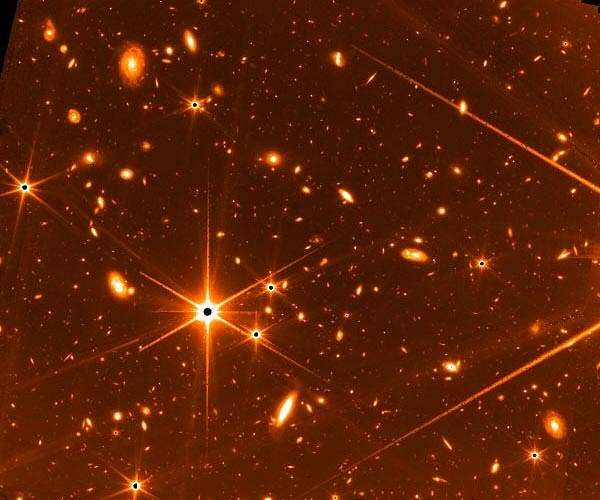
NASA releases James Webb telescope ‘teaser’ picture (Image Credit: Space Daily)
NASA has a provided a tantalizing teaser photo ahead of the highly-anticipated release next week of the first deep-space images from the James Webb Telescope — an instrument so powerful it can peer back into the origins of the universe.
The $10 billion observatory — launched in December last year and now orbiting the Sun a million miles (1.5 million kilometers) away from Earth — can look where no telescope has looked before thanks to its enormous primary mirror and instruments that focus on infrared, allowing it to peer through dust and gas.
The first fully formed pictures are set for release on July 12, but NASA provided an engineering test photo on Wednesday — the result of 72 exposures over 32 hours that shows a set of distant stars and galaxies.
The image has some “rough-around-the-edges” qualities, NASA said in a statement, but is still “among the deepest images of the universe ever taken” and offers a “tantalizing glimpse” at what will be revealed in the coming weeks, months, and years.
“When this image was taken, I was thrilled to clearly see all the detailed structure in these faint galaxies,” said Neil Rowlands, program scientist for Webb’s Fine Guidance Sensor at Honeywell Aerospace.
Jane Rigby, Webb’s operations scientist at NASA’s Goddard Space Flight Center, said the “faintest blobs in this image are exactly the types of faint galaxies that Webb will study in its first year of science operations.”
NASA administrator Bill Nelson said last week that Webb is able to gaze further into the cosmos than any telescope before it.
“It’s going to explore objects in the solar system and atmospheres of exoplanets orbiting other stars, giving us clues as to whether potentially their atmospheres are similar to our own,” he said.
“It may answer some questions that we have: Where do we come from? What more is out there? Who are we? And of course, it’s going to answer some questions that we don’t even know what the questions are.”
Webb’s infrared capabilities allow it to see back in time to the Big Bang, which happened 13.8 billion years ago.
Because the Universe is expanding, light from the earliest stars shifts from the ultraviolet and visible wavelengths it was emitted in, to longer infrared wavelengths — which Webb is equipped to detect at an unprecedented resolution.
At present, the earliest cosmological observations date to within 330 million years of the Big Bang, but with Webb’s capacities, astronomers believe they will easily break the record.
Related Links
Stellar Chemistry, The Universe And All Within It
|
|
Tweet |
|
|
|
We need your help. The SpaceDaily news network continues to grow but revenues have never been harder to maintain. With the rise of Ad Blockers, and Facebook – our traditional revenue sources via quality network advertising continues to decline. And unlike so many other news sites, we don’t have a paywall – with those annoying usernames and passwords. Our news coverage takes time and effort to publish 365 days a year. If you find our news sites informative and useful then please consider becoming a regular supporter or for now make a one off contribution. |
||
|
SpaceDaily Monthly Supporter $5+ Billed Monthly |
SpaceDaily Contributor $5 Billed Once credit card or paypal |
|
The futuristic South Pole Telescope looks far back in time
Lemont IL (SPX) Jul 06, 2022
Surveying the cosmos from its isolated position in Antarctica, a collaborative project aims to reveal insights about the universe’s beginnings.
In summer at the South Pole, which lasts from November through February, the average temperature is a biting minus 18 degrees F. The sun does not set during this time, making sleep a challenge. The environment is harsh and dry. And the Internet connection at the Amundsen-Scott South Pole Station, when you can access it, is painfully slow.
On the other han … read more









